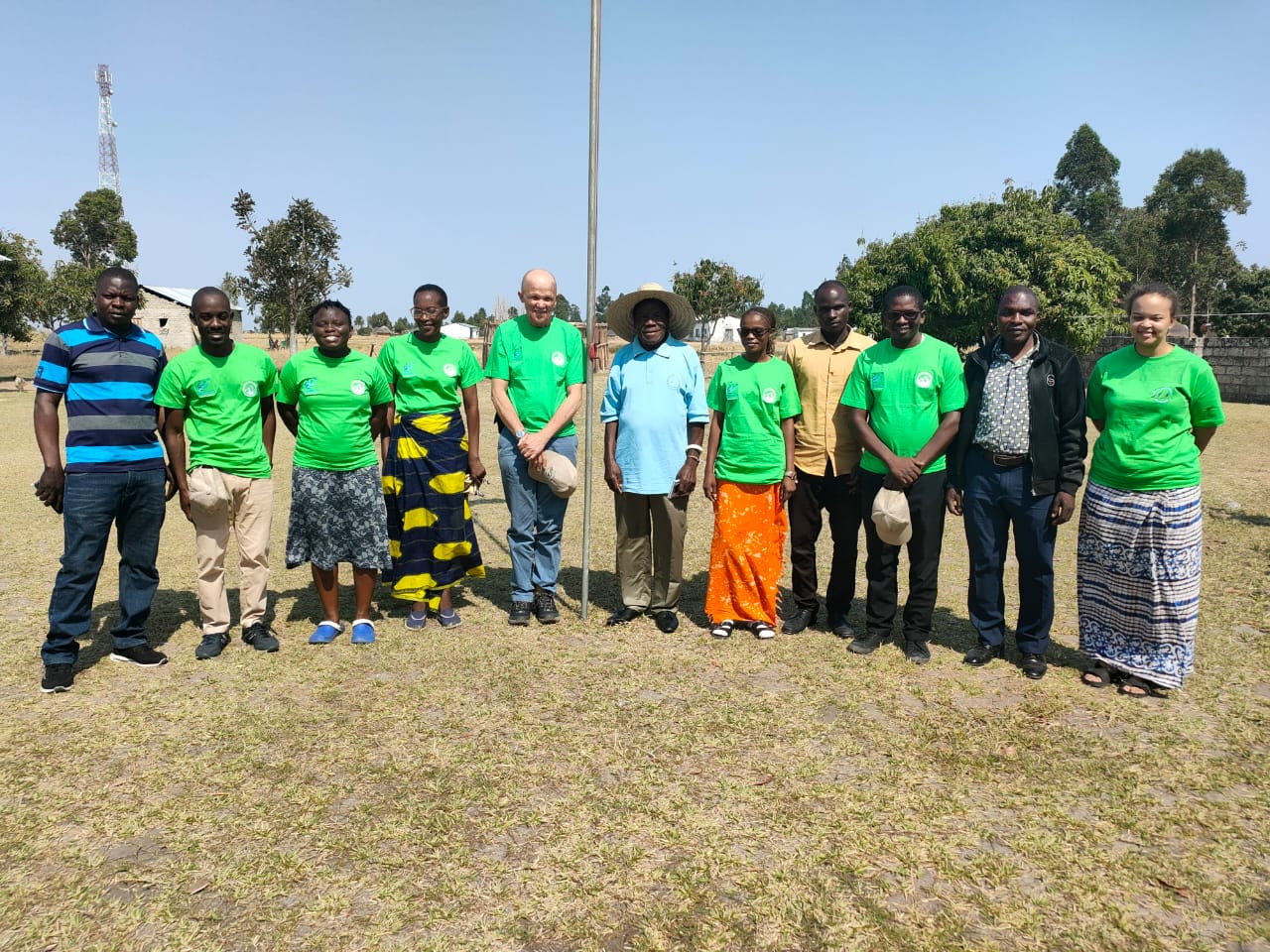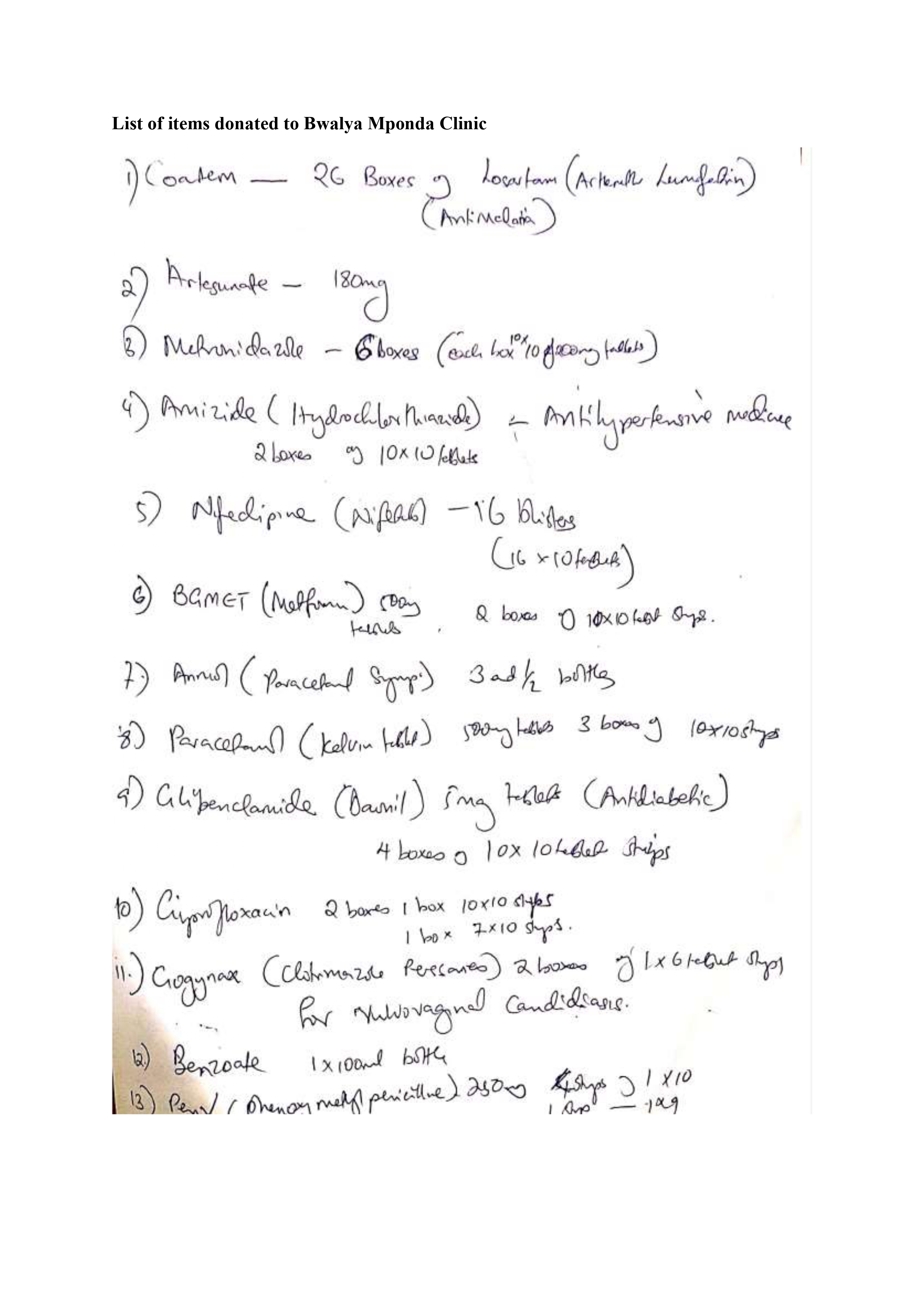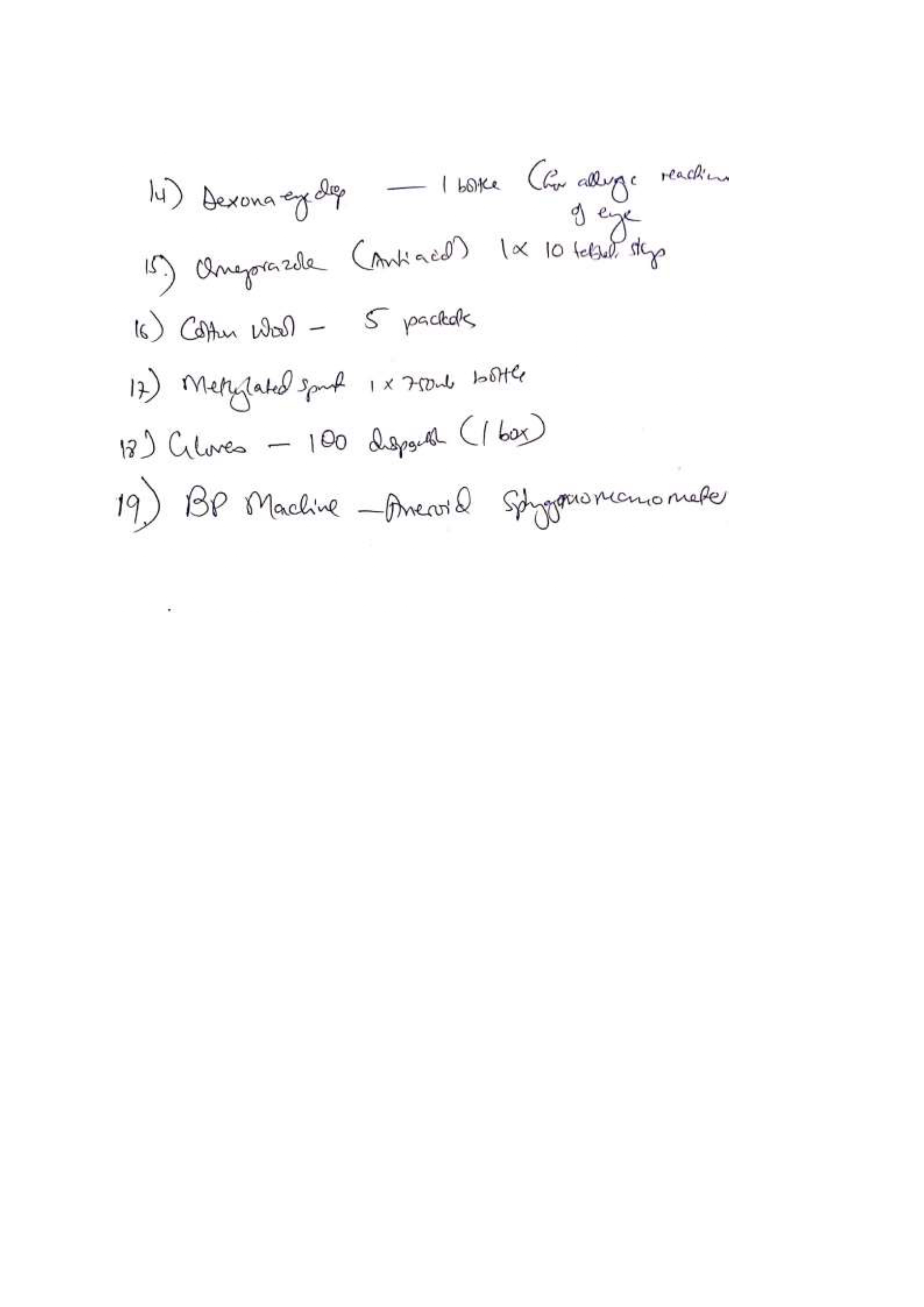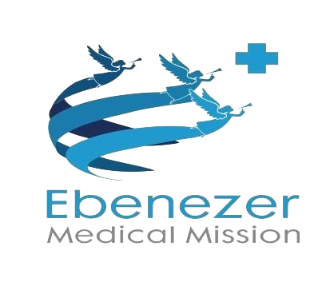
Mission Trip to Bwalya Mponda Island Lunga District
Site
An open-air clinic was ran from Tuesday 27th September 2022 to Friday 30th September 2022
at the “Camp” which is the National Assembly Office for Bwalya Mponda, courtesy of the
local area Member of Parliament. Medical services offered included screening, treatment and
health education on a wide range of conditions. Both Outpatient and inpatient (at the local
clinic) healthcare services were provided.
A summary of the demographics and disease conditions is indicate in Tables 1 and 2 below.
Table 1: Demographic Data: Open Clinic
| Demographics | Number | Percentage (%) |
|---|---|---|
| Total Number of People seen | 175 | 100 |
| Males | 63 | 36 |
| Females | 112 | 64 |
| Ages | ||
| Under 5 years | 21 | 12 |
| 5 - 10 years | 7 | 4 |
| 11 - 19 years | 15 | 8.6 |
| > 20 years | 132 | 75.4 |
| Denomination | ||
| Seventh-day Adventist | 45 | 25.7 |
| Non-Seventh-day Adventist | 72 | 41.1 |
| Denomination not captured | 58 | 33.1 |
In total, 175 patients were registered, the vast majority (75%) of whom were adults. Among those for whom denomination was captured, 62% were non Seventh Day Adventists.
Table 2: Summary of Medical Conditions
| Medical Condition(s) | Num/Sum | Percentage (%) | Additional Comment |
|---|---|---|---|
| Cardiovascular | |||
| Hypertension | 13 | 7.4 | 5 Newly diagnosed, remaining not on medications due to stock outs at clinic |
| Central Nervious System & Musculoskeletal | |||
| Migraines | 6 | 3.4 | |
| Epilepsy | 2 | 1.1 | |
| Chronic back and join pain | 9 | 5.1 | |
| Congenital Talipes Equinovarus | 2 | 1.1 | |
| Left foot drop | 1 | 0.6 | |
| Peripheral Neuropathy | 1 | 0.6 | |
| Peripheral Neuropathy | 1 | 0.6 | |
| Osteomyelitis | 1 | 0.6 | |
| Eye Problems | 20 | 11.4 | |
| Dental | |||
| Multiple Dental Carries | 1 | 0.6 | |
| Gastrointestinal | |||
| Chronic abdominal pains (?PUD, Gastritis, Dyspepsia, GORD) | 26 | 14.9 | |
| Acute Diarrheal Diseases | 5 | 2.9 | |
| Haemorrhoids | 2 | 1.1 | |
| Rectal Prolapse | 1 | 0.6 | |
| Genital-Urinary/Obstetrics & Gynacology | |||
| Abnormal Uterine Bleeding | 1 | 0.6 | |
| Secondary subfertility | 2 | 1.1 | |
| Genital Warts | 1 | 0.6 | |
| Vaginal Candidiasis | 3 | 1.7 | |
| Dysmenorrhea | 1 | 0.6 | |
| Chronic Pelvic Pain (?PID) | 1 | 0.6 | |
| Septic Abortion | 1 | 0.6 | |
| Haemotological | |||
| Sickle Cell Anemia | 1 | 0.6 | |
| Integumentary | |||
| Scabies | 28 | 16.0 | NB: People receiving scabies medication indicated that it was a household issue therefore the numbers were much higher than highlighted |
| Allegic Skin rash | 2 | 1.1 | |
| Chronic Leg Ulcer | 1 | 0.6 | |
| Respiratory | |||
| Upper Respiratory Tract Infections | 4 | 2.3 | |
| Tuberculosis | 9 | 5.1 | 6 Confirmed on Treatment, 2 Suspected (Matted lymph nodes in neck region, children),1 suspected recurrence in adult, One post Obstetric Fistula repair, Another Post Depo-Provera injection |
| Asthma | 2 | 1.1 | |
| Systemic | |||
| Malaria | 6 | 3.4 | All Children under the age of 5 |
| Tumours | |||
| Right Scrotal Mass | 1 | 0.6 | |
| Testicular Mass | 1 | 0.6 | |
| Upper Eyerbrow mass | 1 | 0.6 | |
| Left Arm mass | 1 | 0.6 | |
| Right Hip Mass | 1 | 0.6 | |
| Abdominal Tumour (Massive Left to Right) | 1 | 0.6 | |
| Other NCD's | |||
| Diabetes Mellitus | 1 | 0.6 | Newly diagnosed, in elderly Male |
Disease Burden
The conditions affecting the community-included congenital anomalies (such as Talipes Equinovarus), communicable and non-communicable diseases. The top 5 conditions affecting the locals, in decreasing order, were, Scabies, Gastrointestinal Problems, Eye problems, Hypertension, Tuberculosis and Hypertension.
Scabies affected multiple households and the numbers represented in table 2 or for a single household member who often collected enough Benzoate to treat other family members affected by the same condition. The number of TB cases is alarming for the small community. Though only a few are indicated, a good number of people gave a positive family history of TB. Moreover, three children were noted to have generalised lymphadenopathy. One of whom was on TB treatment and two were suspected to have TB. Malaria was another infectious disease that was common. All Malaria positive tests were in children under the age of 5.
Predisposing Factors
Poor sanitary conditions and water pollution:
The toilet facilities in the area are inadequate, with very few VIP toilets. Even at the school (Primary and Secondary) there were inadequate number of toilets for the students. This coupled with few facilities for washing hands, predisposes community members to diarrheal diseases. Additionally, the water from the lake was noted to be contaminated on testing. Only water from the borehole was found to be clean on water testing. It is of note however that the area is serviced by only one borehole, and households are subdivided in sections, with each section having access to the borehole once weekly. This also predisposes the community to water borne diseases, as noted with Acute Diarrheal Diseases. The children under the age of 5 appear to be particularly vulnerable.
Dietary Defciencies
The diet in the area is lacking in foods that contain beta-carotene. No foods containing yellow coloured nor orange coloured plant phytochemicals were noted in the whole community and the market. Moreover, the majority of people grind their maize locally, which means the maize is not fortified with Vitamin A. Through the farm stew program, community members were encouraged to grow carrots, yellow peppers and yellow/orange sweet potatoes to mitigate for the [present deficiencies. The present situation might explain the high percentage of people with visual problems as well as musculoskeletal body aches.
Lack of/ inappropriate use of Mosquito Nets:
Community members indicated inadequate availability of insecticide treated nets. During walks in the community, some nets were noted being used as garden nets. Others we were informed sometimes used these for fishing. There is need for Implementation Research in the are to ascertain the bottlenecks in malaria prevention and control so as to improve the situation. The are being a swamp, we were reliably informed that Malaria cases peak in the rain season.
Drug Stock outs and inadequacies at the Local Clinic
There are inadequate supplies of drugs and medical supplies at the local clinic. Notably, the lack of surgical gloves, strapping, inadequate stock of fluids like normal saline and antihypertensive to mention a few. The Blood Pressure Machine at the facility was also not working due to lack of batteries (the team however donated a manual BP machine to the facility). This made monitoring of critical patients before referral difficult. The majority of hypertensive patients were inconsistent with taking anti-hypertensive drugs due to stock-outs. These health system challenges need to be addressed to prevent unnecessary mortality. Additionally, epilepsy appears to be common in the community; however, there are no oral anticonvulsants available at the local clinic. Despite the seemingly high number of TB cases, there appears to be no active surveillance and initiation of prophylaxis to other family members/care givers.
NB: See attachment for list of items donated to the local clinic at the end of the visit.
Health Education: Visit to the School
A visit to the local school, Bwalya Mponda Secondary School was done as part of a health awareness campaign. The students included Grade 6 to Grade 12 pupils. A range of issues affecting adolescents was addressed including, sexually transmitted diseases (like HIV and Syphilis), teenage pregnancy, alcohol and substance abuse as well as sanitation and mental health. Additionally career guidance was done.
Recommendations
1. Ministry of Health to prioritise and strengthen Malaria control, TB control (including Prophylaxis), medicines and drugs as well as increase diagnostic capacity i.e Xray Machine
2. Ministry of Health to organise an outreach for Ophthalmologists to the area
3. Community project on growing a variety of fruits and vegetables particularly the yellow and orange coloured vegetables like carrots and orange sweet potatoes which are lacking in the diet.
4. Community education on Sanitation and building of VIP toilets as well as handwashing facilities
5. Local Authorities to sink more boreholes in the community to increase access to safe drinking water



